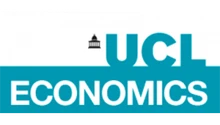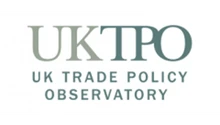The annual rate of food price inflation in the UK has accelerated to 4.5%. Behind the increase is a blend of supply shocks, policy changes and climate disruption that together have pushed food costs well above general inflation.
Since 2022, food price increases in the UK have outstripped headline inflation by a significant margin (see Figure 1). In the year to June 2025, food and drink costs increased by 4.5%, well ahead of the overall annual inflation rate of 3.6%, as measured by the latest consumer prices index (CPI).
Figure 1. Food and drink inflation
Note: Food and drink inflation, compared to overall CPI.
Source: Office for National Statistics (ONS).
Although this is far from the heights of post-Covid-19 inflation, when the annual rate of increase for food prices hit 19% in March 2023, food price growth has picked up pace. At this point last year, food and drink inflation lagged CPI. It is now running almost a percentage point higher and continues to accelerate. Food and drink inflation has now risen in four of the last six months.
What kinds of food have increased in price the most?
Increases in food costs have been distinctly uneven across categories. Over the last few months, chocolate has received the most attention, with ‘choc-flation’ now appearing in headlines. Indeed, chocolate has experienced the most dramatic price increases of any major food category. Prices are up by 16% in the past year alone, with cumulative inflation reaching 43% since 2022.
Soaring prices of raw cocoa are to blame (see Figure 2). Over the last two years, global cocoa prices have more than tripled, climbing from $2,900 in May 2023 to $9,000 in May 2025. Dry weather across West Africa, especially Ghana and the Ivory Coast (which together supply around 70% of cocoa beans), has harmed harvests. In addition, an infection called cacao swollen shoot virus is killing trees at an alarming rate.
Figure 2. Global cocoa prices
Note: US dollars per metric ton, not seasonally adjusted.
Source: International Monetary Fund via FRED (PCOCOUSDM).
Although this is a dramatic price increase, and one with important humanitarian consequences, increased chocolate prices have not been the primary driver of UK inflation over the last year. This is because they represent a relatively low share of household spending.
The Office for National Statistics (ONS) calculates food inflation by collecting prices from shops around the country. The headline figure typically reflects the percentage change in the index compared to the same month one year earlier – a year-on-year measure of inflation. Not all products have the same effect on the overall ‘basket’ of items: weighting different products allows price statistics to reflect typical household spending patterns (see Figure 3).
Figure 3. Food inflation by product category
Notes: Annual inflation for food and non-alcoholic drink subclasses; bars sized by subclass weight.
Source: ONS, author’s calculations.
Some products see high inflation but carry relatively low weight in overall spending – cocoa belongs in this category. While the commodity has seen by far the highest inflation over recent months, its parent category – coffee, tea and cocoa – makes up just 2.7% of the food inflation basket.
Others show low inflation with low weight and barely register in the overall figures. Fish products have seen both low spending and low inflation.
But the products that push up inflation the most are those with both high price increases and heavy weighting in household budgets. Over the past year, meat has been the prime example, with prices growing an annual rate of 5.7%. This food category accounts for £24 billion of household spending a year.
Indeed, meat prices have contributed more to food inflation over the past year than any other category (see Figure 4). Deadweight beef prices – the prices that farmers receive for finished cattle at abattoirs – have increased by 40% over the past year.
Figure 4. Beef prices, 2024 and 2025
Source: Agriculture and Horticulture Development Board (ADDB).
This price surge reflects severe supply constraints. UK beef production is expected to fall by 5% year-on-year to 885,000 tonnes, following sustained reductions in cattle numbers. Reduced profitability, declining direct payments and strong beef prices have encouraged farmers to sell rather than breed, the AHDB reports. Some, but not all, of the raw carcass price increase has been passed on to consumers. Beef prices are up by 17% over the past year – a large driver of overall food inflation.
Have minimum wage and national insurance rises increased food prices?
Two prominent policy changes have also received blame for rising food inflation: the increases in national insurance contributions (NICs) and the minimum wage.
In April, employer NICs rose from 13.8% to 15% of pay, while the threshold for paying contributions fell sharply from £9,100 to £5,000 per employee annually. At the same time, the government implemented significant increases in the national living wage on the advice of the Low Pay Commission. The rate rose by 6.7% from £11.44 to £12.21 an hour for employees over 21, with larger percentage increases for younger workers.
The measures disproportionately affect companies that employ lower-paid, young and part-time workers. Positions with lower hourly rates or part-time hours – and a resulting low income – are also most likely to be affected by the reduction in the NICs threshold.
Figure 5. Low pay by industry
Notes: Low paid jobs are those earning less than two-thirds of the national median.
Accommodation and food workers are the employees most likely to be low earners in the UK (see Figure 5), with the retail sector also vulnerable to these changes. According to the British Retail Consortium (BRC), the sector has 1.5 million part-time jobs, representing around half of all positions. Almost one-fifth of retail workers are under the age of 25.
Industry leaders have been vocal about this difficult climate. Helen Dickinson, BRC chief executive, said retailers face ‘a mountain of new employment costs in the form of higher employer national insurance contributions and increased national living wage’.
Even so, the evidence remains mixed. The factors that make food most exposed to the policy changes are not unique: hospitality and non-food retail face the same workforce challenges. It would be natural, therefore, to expect similar price increases, but this has not been the case.
Food prices have surged, while other sectors have stagnated. In fact, restaurants, cafes and hotels have seen 2.6% inflation over the past year – lower than overall inflation. The clothing and footwear category is even lower, at 0.5% over the last year.
While food retail is not alone in its exposure to employment cost pressures, it is unusual in the extent of the inflation it has seen. This implies that employment effects may not be the dominant factor shaping prices.
Where next?
The present supply shocks (for example, in chocolate and beef production) are likely to fade over time. Although prices could remain elevated for some time, similar rises in other commodities have eventually cooled. For example, between 2019 and 2024, olive oil experienced the largest price increase of any food item, soaring by 113.8%. Since then, the prices have begun to decline as Spanish harvests recover.
In the long run, climate change makes food price shocks more frequent and severe. Changing weather patterns increase volatility and threaten stable harvests across key growing regions.
The effects are already filtering through to prices. Sarah Breeden, the Bank of England's deputy governor for financial stability, argues that climate risks once seeming ‘hypothetical or far off in the distance’ are now ones ‘that could materialise, and in some cases already are materialising’. Whatever happens to beef and chocolate prices, the future will carry more food price volatility.
Where can I find out more?
Read more about food inflation and the reasons behind it
- What's the state of the agri-food chain in the UK? The Department for Environment, Food & Rural Affairs' Pocketbook collects accredited official statistics on production, employment and prices.
- Cocoa prices have risen but West Africa's farmers are not benefiting. Financial Times.
- Each week, the Agriculture and Horticulture Development Board releases detailed statistics on livestock, dairy and agriculture prices.
Find out more about inflation from the Economics Observatory:
- Why has UK inflation risen? In April, Finn McEvoy investigated the sources of this year's surge.
- What are the links between job vacancies, unemployment and inflation? Read Fergus Jimenez-England on the links between the labour market and inflation, and the puzzle of why unemployment has remained historically low despite rising interest rates.
- What are the future prospects for UK inflation? In June 2024, Huw Dixon explored what falling inflation means for the future amid domestic and global risks.
- Can artificial intelligence help us to measure inflation? Economics Observatory research into how AI tools can improve the speed, cost, and breadth of inflation measurement.









































